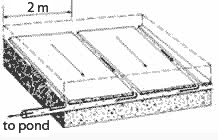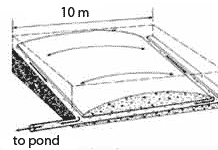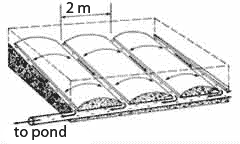Feedpads and stand-off areas
Feedpads and stand-off areas are used to get cows off wet paddocks as part of a strategy to:
- reduce pasture and soil damage
- improve pasture utilisation
- increase pasture regrowth
- improve animal welfare
These strategies can take the form of:
- simple on-off grazing where cows are taken off the paddock for part of the day, or
- cows being held off-pasture for several weeks
Using existing facilities
There are several options available if animals need to be taken off-paddock, ranging from the inexpensive to the expensive.
Laneways
An expensive option is to stand cattle off on a well-constructed laneway. This should only be regarded as a short-term option as continual use of the laneway can lead to extensive damage of the laneway surface.
It's best to split the herd into mobs of 50 to 60, kept apart with single strands of electrified tape. This prevents the mob from constantly moving up and down the lane and damaging it further.
Dairy yard
The dairy yard can be used to hold cattle for longer periods of time. In New Zealand, it's not unusual for dry cows to be held in dairy yards for up to 20 hours.
To prevent lameness from standing on concrete for long hours, allow the cows to walk along a laneway halfway through the stand-off period.
Advantages of using the yard for long periods include the following:
- Cows are used to standing in the yard.
- You're using existing infrastructure.
- It is easy to dispose of effluent.
Some of the disadvantages are:
- The yard may be too small — cows need an area at least 2.5 to 3 square metres per cow if standing for extended periods.
- It must be kept free of stones otherwise lameness can become an issue.
- You must dispose of extra effluent generated.
Sacrifice paddocks
A 'sacrifice paddock' can be a suitable low-cost option on many farms.
- Choose a paddock for a sacrifice paddock (usually one with a run-down pasture).
- Move cows onto it for the rest of the day as part of on-off grazing during wet conditions. If used for more than a few days, the pasture will usually be severely damaged and require a full pasture renovation.
- After the winter, sacrifice paddocks are normally cultivated and sown to a summer fodder crop to level and restore the soil.
- The pasture is then re-sown the following autumn.
Disadvantages include
- the risk of soil structure damage
- possible animal health problems such as lameness and mastitis
Avoid using paddocks adjacent to streams or drains to reduce the risk of soil and nutrient movement to these waterways.
Loafing-pads or stand-off areas
More permanent (and expensive) facilities include short-term loafing-pads or stand-off areas.
A loafing-pad is a purpose-built free-draining area used for holding stock off-paddock during wet conditions.
Selecting a site
When sighting a pad, select an area that faces north or northeast for:
- maximum exposure to the sun
- protection from the prevailing winds
An area of 9 square metres per cow is required, not including the feeding area. For ease of use, try and have it close to the existing facilities.
Check with your local shire to see if you require an intensive operation permit.
Effluent disposal
It's important that any waste from the pad complies with local, regional and state regulations and does not:
- leave the farm
- create odours
- pollute any water course or ground water
Ideally the dairy and pad waste storage should be the same, as this will save on the cost, but it's important to make sure that your existing pond can hold the extra effluent that's generated from the pad.
Construction
Suitable covering materials for loafing-pads include rice hulls, sawdust and wood chips, depending on price and availability. Ensure that enough fill is placed in the loafing-pad. A guide is to allow 6 cubic metres for each animal.
It should be 600mm to 900mm deep or slightly less if on a gravel base. A gravel base 200mm thick will improve drainage.
Design of the base
Good drainage is essential for a successful loafing-pad. To get the best drainage from the pad there are a few options that are available depending on the natural slope and soil type. Whatever type you decide on, the effluent drained from the pad must then be drained away from the pad and into an effluent system.
Slope base (Figure 1)

This uses the natural drainage of existing land, so it needs a site with a minimum natural fall of 1:20. Drainage can be improved by laying slotted drainage pipes 1.5 to 2m apart. If pipes are used, the bottom layer of fill should be gravel.
Clay dome base (Figure 2)
On suitable soils, the site can be cleared of topsoil to expose the clay layer, which is graded to form a centre ridge with a fall to each side of the pad. The dome should be 10m wide with a ridge of at least 500mm higher than the edges.

Drainage ditches or pipes are needed at each side of the ridge. If pipes are used, the initial fill should be gravel or rock.
Hump and hollow base (Figure 3)
This suitable for land with little natural fall. The topsoil is removed then humps and hollows are formed at 2m intervals.
Drains (for example, a slotted drainage pipe) in the hollows are necessary to take effluent to a main drain away from the pad. A gravel layer of 200mm is recommended over the top of the slotted drainage pipe.

Feedpads
A dairy feedpad is a confined yarded area that provides adequate water, space, facilities and has an effective waste removal system to allow for the regular feeding of the whole herd. It should be constructed to withstand heavy traffic and be easily cleaned.
The feeding area should be from 4m to 5m wide to allow stock to move on and off the area and access feed.
A wall 100mm to 120mm high at the rear of the feeding area will reduce the spread of pad material on the area. The length of the feeding area will depend on the amount of access time allowed to supplements. With 24-hour access to unlimited supplements, 0.2m per cow is needed. However, if limited amount of supplement is fed, allow 0.6m per cow to ensure that all cows can get access at the same time.
It is important to remember that milking cows require about 100 litres of water a day, so adequate water supply is a must. Troughs should be located away from the feeding area to stop bullying animals dominating both, and on concrete to reduce breakdown of the surrounding area.
Water Act
The Water Act 1989 provides guidance for the management of waterways and swamps. Before considering draining a wet area, contact your local catchment management authority for advice and to check if you need a permit.